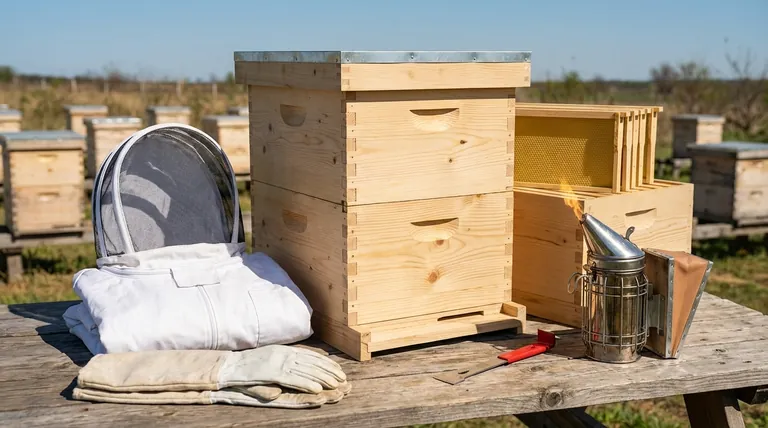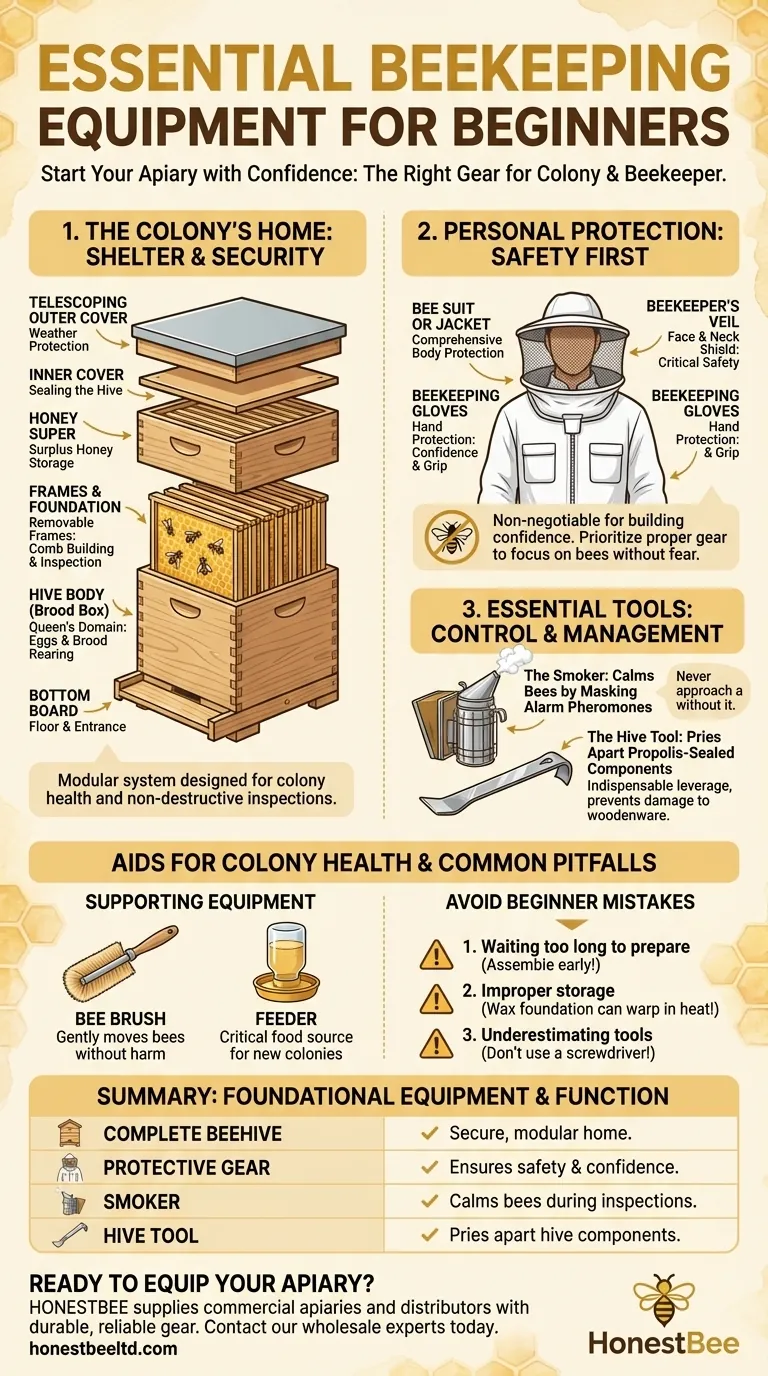Starting your beekeeping journey requires a specific set of equipment designed for two purposes: providing a home for your bees and allowing you to interact with them safely. The absolute essentials are a complete beehive, protective clothing (like a veil and gloves), a smoker to calm the bees, and a hive tool to manipulate the hive components. These items form the non-negotiable core of any beginner's kit.
Your success as a new beekeeper is not about having the most gear, but the right gear. The focus should be on three distinct categories: a secure home for the colony, essential protection for yourself, and the two primary tools needed for any hive inspection.

The Core Components: Shelter, Safety, and Tools
Understanding the function of each piece of equipment is critical. They are not arbitrary items but are part of a system that has been refined over centuries to support both the beekeeper and the honey bee colony.
The Beehive: Your Colony's Home
The beehive is the most complex piece of equipment. Most beginners start with a Langstroth hive, which is a modular system of stackable boxes.
A standard hive consists of a bottom board, which serves as the floor and entrance. Above this sits the main hive body (or "brood box"), where the queen lays her eggs and the colony raises its young.
Inside the hive body are frames with foundation. These removable frames are where bees build their comb, store food, and raise brood. This design is the key to modern beekeeping, allowing for inspection without destroying the nest.
As the colony grows, you will add honey supers—smaller boxes placed above the main hive body—for the bees to store surplus honey. An inner cover and a telescoping outer cover seal the hive from the elements.
Personal Protection: Your First Line of Defense
Proper protective gear is non-negotiable for building confidence and ensuring your safety. While some experienced beekeepers work with minimal protection, beginners should always prioritize it.
The most critical items are a beekeeper's veil to protect your face and neck, and a good pair of beekeeping gloves.
Many beginners opt for a full bee suit or jacket, which provides comprehensive protection and peace of mind. This allows you to focus on the bees and learn their behavior without the constant fear of being stung.
Essential Tools: The Smoker and Hive Tool
While the hive is for the bees, two tools are absolutely essential for the beekeeper. You should never approach a hive for an inspection without them.
The smoker is a small, fire-proof canister with a bellows. Puffs of cool, white smoke mask the bees' alarm pheromones, which keeps the colony calm during inspections.
The hive tool is a small crowbar used to pry apart hive bodies and frames, which bees often seal together with a sticky resin called propolis. It is indispensable for any hive manipulation.
Supporting Equipment: Aids for Colony Health
Beyond the core essentials, a few other items are highly recommended for managing a healthy colony.
A bee brush has soft bristles used to gently move bees off a frame without harming them. This is especially useful when you need a clear view or are harvesting honey.
Feeders are also important, particularly for new colonies. These devices hold sugar syrup, providing a crucial food source when natural nectar is scarce, helping the colony establish itself quickly.
Common Pitfalls for New Beekeepers
Knowing what equipment to get is only half the battle. Avoiding common mistakes in preparation and use is just as important for a successful first year.
Waiting Too Long to Prepare
Beekeeping equipment, especially the hive bodies and frames, often arrives unassembled. You must purchase your gear well in advance of your bees' arrival.
This gives you the necessary time to assemble all the components and apply a protective coat of paint or wood sealant to the exterior parts of the hive.
Improperly Storing Components
Frames often come with wax foundation sheets that must be installed. Do not install these sheets until you are ready to put the bees in the hive.
If stored for long periods, especially in warm temperatures, the delicate wax can stretch, sag, or warp, rendering the frames useless.
Underestimating Your Tools
Some beginners are tempted to open a hive without a smoker or try to use a screwdriver instead of a proper hive tool. This is a mistake.
The smoker is your primary tool for keeping the colony calm and yourself safe. A hive tool is specifically designed to pry open propolis-sealed boxes with the right amount of leverage, preventing damage to your woodenware.
Making the Right Choice for Your Goal
Your initial equipment purchase should align with your priorities as a new beekeeper.
- If your primary focus is safety and confidence: Invest in a full bee suit or a high-quality jacket and veil combination, not just a simple veil.
- If your primary focus is budget: Start with the absolute necessities: one complete hive, a veil, gloves, a smoker, and a hive tool. You can add items like a bee brush or extra supers later.
- If your primary focus is a smooth start for your bees: Purchase your equipment early, assemble it correctly, and have a feeder ready with sugar syrup before your bee package arrives.
Starting with the right foundational equipment empowers you to manage your colony effectively and confidently from day one.
Summary Table:
| Essential Equipment | Primary Function | Key Consideration |
|---|---|---|
| Complete Beehive | Provides a secure, modular home for the colony. | Most beginners start with a Langstroth hive system. |
| Protective Gear (Veil/Gloves) | Ensures your safety and builds confidence. | A full bee suit is recommended for maximum protection. |
| Smoker | Calms bees during inspections by masking alarm pheromones. | Never open a hive without it. |
| Hive Tool | Pries apart hive components sealed with propolis. | A specialized, indispensable tool for any inspection. |
Ready to equip your apiary with confidence?
HONESTBEE supplies commercial apiaries and beekeeping equipment distributors with the durable, reliable gear needed for success. We understand that your operation depends on high-quality foundations. Let us provide the essential equipment that supports healthy colonies and productive beekeepers.
Contact our wholesale experts today to discuss your specific needs and get started.
Visual Guide

Related Products
- Langstroth Bee Hives Bee Keeping Box for Beginners Beekeeping
- HONESTBEE Professional Long Handled Hive Tool with Precision Cutting Blade
- HONESTBEE Advanced Ergonomic Stainless Steel Hive Tool for Beekeeping
- HONESTBEE Professional Multi-Functional Hive Tool with Ergonomic Wood Handle
- Multi-Function Plier-Style Frame Grip Hive Tool
People Also Ask
- Why might a beginner be advised to start with a Langstroth hive? Unlock a Supportive Beekeeping Ecosystem
- What is the best type of bee hive for beginners? Start with the Proven Langstroth Standard
- What are the different types of beehive boxes available? Choose the Right Hive for Your Apiary
- Why were wooden hives traditionally preferred? For Natural Beekeeping Aligned with Bee Biology
- How does the orientation of the hive sides benefit comb construction? Ensure Straight, Movable Combs for Easier Hive Management



















